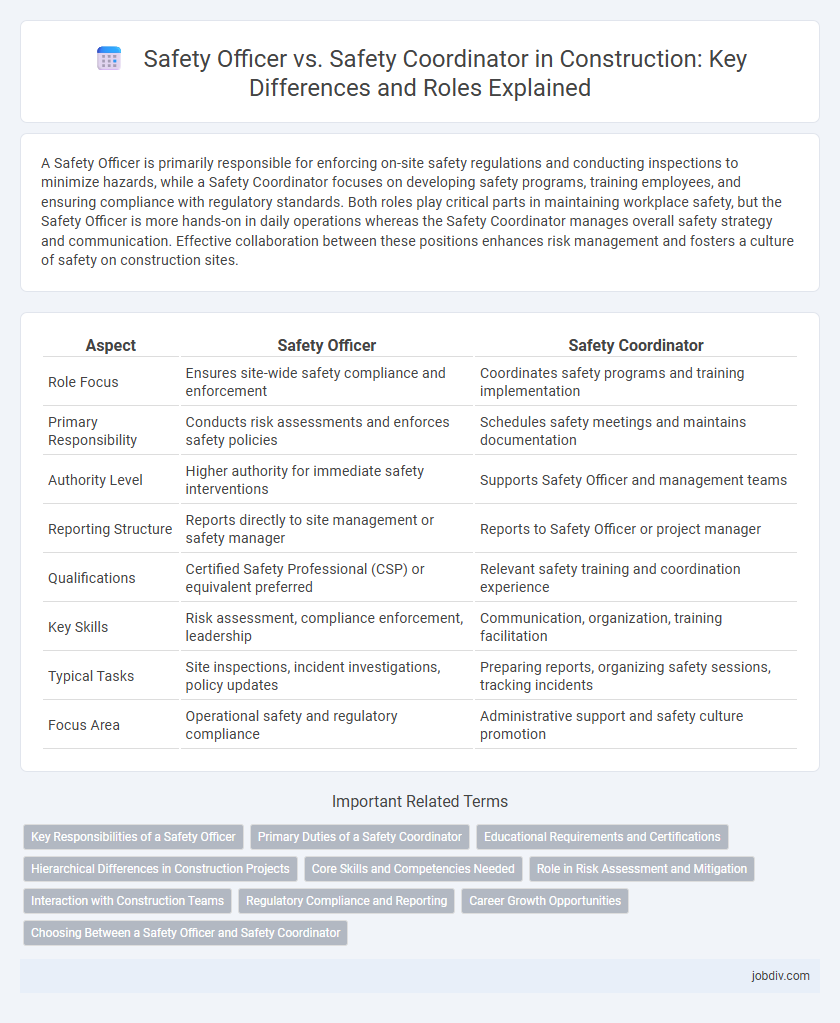A Safety Officer is primarily responsible for enforcing on-site safety regulations and conducting inspections to minimize hazards, while a Safety Coordinator focuses on developing safety programs, training employees, and ensuring compliance with regulatory standards. Both roles play critical parts in maintaining workplace safety, but the Safety Officer is more hands-on in daily operations whereas the Safety Coordinator manages overall safety strategy and communication. Effective collaboration between these positions enhances risk management and fosters a culture of safety on construction sites.
Table of Comparison
| Aspect | Safety Officer | Safety Coordinator |
|---|---|---|
| Role Focus | Ensures site-wide safety compliance and enforcement | Coordinates safety programs and training implementation |
| Primary Responsibility | Conducts risk assessments and enforces safety policies | Schedules safety meetings and maintains documentation |
| Authority Level | Higher authority for immediate safety interventions | Supports Safety Officer and management teams |
| Reporting Structure | Reports directly to site management or safety manager | Reports to Safety Officer or project manager |
| Qualifications | Certified Safety Professional (CSP) or equivalent preferred | Relevant safety training and coordination experience |
| Key Skills | Risk assessment, compliance enforcement, leadership | Communication, organization, training facilitation |
| Typical Tasks | Site inspections, incident investigations, policy updates | Preparing reports, organizing safety sessions, tracking incidents |
| Focus Area | Operational safety and regulatory compliance | Administrative support and safety culture promotion |
Key Responsibilities of a Safety Officer
A Safety Officer in construction is primarily responsible for enforcing safety regulations, conducting site inspections, and ensuring compliance with OSHA standards to prevent accidents and injuries. They develop safety protocols, perform risk assessments, and coordinate safety training programs for all construction workers. Monitoring hazard control measures and maintaining safety documentation are essential duties to promote a secure working environment on-site.
Primary Duties of a Safety Coordinator
A Safety Coordinator in construction is primarily responsible for implementing safety programs, conducting regular site inspections, and ensuring compliance with OSHA regulations to minimize workplace hazards. They coordinate safety training sessions, track incident reports, and collaborate with project managers to promote a culture of safety on site. Unlike Safety Officers who oversee overall safety strategy, Safety Coordinators focus on the day-to-day enforcement of safety policies and practical risk management.
Educational Requirements and Certifications
Safety Officers typically require a minimum of a bachelor's degree in occupational health and safety, construction management, or a related field, alongside certifications such as OSHA 30-hour, Certified Safety Professional (CSP), or Construction Health and Safety Technician (CHST). Safety Coordinators often hold an associate degree or diploma in safety or construction disciplines and may possess foundational certifications like OSHA 10-hour or First Aid/CPR. Both roles benefit from continuous professional development to stay updated on regulatory standards and industry best practices.
Hierarchical Differences in Construction Projects
In construction projects, the Safety Officer holds a higher hierarchical position than the Safety Coordinator, responsible for overseeing overall site safety protocols and compliance with regulatory standards. The Safety Coordinator supports the Safety Officer by implementing safety measures on the ground and managing day-to-day safety activities among workers. This hierarchical structure ensures clear accountability and efficient communication in maintaining workplace safety.
Core Skills and Competencies Needed
Safety Officers must possess strong risk assessment abilities, knowledge of OSHA regulations, and effective communication skills to enforce safety protocols on construction sites. Safety Coordinators excel in organizing safety programs, coordinating training sessions, and monitoring compliance with regulatory standards to promote a culture of safety. Both roles require expertise in hazard identification, incident investigation, and emergency response planning to minimize workplace accidents.
Role in Risk Assessment and Mitigation
A Safety Officer in construction is primarily responsible for conducting comprehensive risk assessments and implementing mitigation strategies to ensure compliance with occupational safety standards. In contrast, a Safety Coordinator supports these efforts by monitoring site activities, coordinating safety training, and ensuring that hazard controls are effectively communicated and practiced among workers. Both roles are critical in preventing accidents and maintaining a safe construction environment through systematic hazard identification and risk reduction.
Interaction with Construction Teams
Safety Officers engage directly with construction teams to identify hazards, enforce safety protocols, and conduct on-site inspections, ensuring compliance with OSHA standards. Safety Coordinators facilitate communication between management and construction workers, organize safety training sessions, and assist in incident investigations to promote a culture of safety. Both roles require strong interaction skills to effectively mitigate risks and enhance workplace safety on construction sites.
Regulatory Compliance and Reporting
Safety Officers ensure regulatory compliance by implementing and monitoring adherence to local, state, and federal construction safety standards, conducting site inspections, and verifying that all safety protocols meet OSHA regulations. Safety Coordinators primarily manage the documentation and reporting process, maintaining accurate records of safety incidents, training sessions, and compliance audits to support regulatory requirements. Both roles collaborate to minimize workplace hazards while ensuring timely submission of mandatory reports to regulatory bodies.
Career Growth Opportunities
Safety Officers in construction typically have broader responsibilities, including on-site risk assessments and enforcing compliance, which positions them for advancement into senior safety management roles. Safety Coordinators often focus on administrative tasks and training logistics, providing a foundation for moving into specialized safety program management or technical advisory positions. Both roles offer distinct career paths, with Safety Officers generally gaining faster access to leadership opportunities within project management and regulatory compliance sectors.
Choosing Between a Safety Officer and Safety Coordinator
Choosing between a Safety Officer and Safety Coordinator depends on the project's scale and specific safety requirements; Safety Officers typically oversee compliance and enforce safety regulations on-site, while Safety Coordinators focus on planning, risk assessment, and communication across teams. Large construction projects benefit from Safety Officers to manage daily hazards and conduct inspections, whereas Safety Coordinators enhance collaboration and strategic safety initiatives in complex developments. Prioritizing qualifications such as OSHA certification and experience in construction safety management ensures effective risk mitigation and regulatory adherence.
Safety Officer vs Safety Coordinator Infographic

 jobdiv.com
jobdiv.com